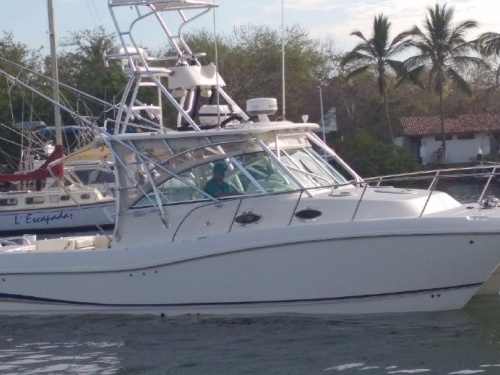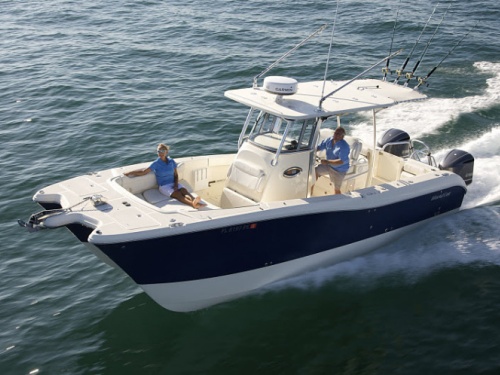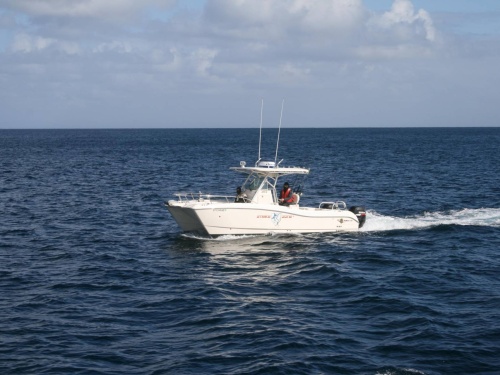Access More Boat Tests
Already have an account? Login
World Cat 280CC-X (2017-)
2 x 200-hp Yamaha Digital 4-strokes
Brief Summary
Cats are generally the most stable boats on the water. With twin hulls, a 9'2" (2.79 m) beam and exceptional freeboard forward, the World Cat 280CC-X is clearly ready for long offshore runs in any fishable weather. Her sheerline and tumblehome present a sleeker look than most cat designs, and the broad bow gives far more deck and seating space than conventional monohulls. Her moderate 7,300 pound (3,311 kg) weight allows her to run well on twin 200s, keeping fuel use to a minimum for the genre.
Key Features
- Bow with LED docking lights, surrounding fascia, and World Cat lettering
- Deck level stainless steel grab rail around bow seating
- Deluxe bow and starboard bow lounge seating 7
- Insulated 36 quart bow cooler compartment
- Fiberglass top with powdercoated frame and built-in windshield
- Six 8" pull-up stainless steel cleats
- Aft fold-down transom seating for 2
- Large user friendly On-Ramp swim ladder
Test Results
| RPM | MPH | Knots | GPH | MPG | NMPG | STAT. MILE | NM | dBa |
|---|---|---|---|---|---|---|---|---|
| 600 | 3.8 | 3.3 | 0.8 | 4.8 | 4.1 | 941 | 817.8 | 61 |
| 1000 | 5.6 | 4.8 | 1.5 | 3.7 | 3.2 | 733 | 637 | 69 |
| 1500 | 7.4 | 6.4 | 2.5 | 3 | 2.6 | 586 | 509.6 | 72 |
| 2000 | 9 | 7.8 | 4.3 | 2.1 | 1.8 | 417 | 362.6 | 76 |
| 2500 | 13.1 | 11.3 | 6.5 | 2 | 1.8 | 401 | 348.4 | 7.8 |
| 3000 | 18.7 | 16.3 | 8.4 | 2.2 | 1.9 | 443 | 385.6 | 9 |
| 3500 | 25.6 | 22.3 | 10.2 | 2.5 | 2.2 | 497 | 432.1 | 86 |
| 4000 | 30.8 | 26.7 | 13.7 | 2.2 | 2 | 444 | 386.4 | 86 |
| 4500 | 36 | 31.3 | 18.6 | 1.9 | 1.7 | 384 | 333.7 | 89 |
| 5000 | 40.7 | 35.4 | 25.6 | 1.6 | 1.4 | 315 | 274.3 | 91 |
| 5500 | 45.2 | 39.3 | 32.7 | 1.4 | 1.2 | 274 | 238.1 | 94 |
| 5900 | 48.7 | 42.3 | 38.6 | 1.3 | 1.1 | 250 | 217.5 | 94 |
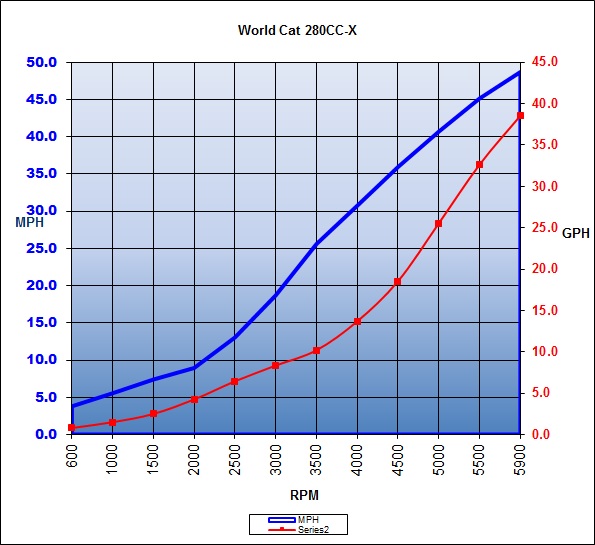
Specifications
| Length Overall | 27’ 6'' / 8.38 m |
|---|---|
| Beam |
9’ 2'' 2.79 m |
| Dry Weight |
7,300 lbs. 3,311 kg |
| Tested Weight |
8,380 lbs. 3,801 kg |
| Draft |
14'' 0.36 m |
| Deadrise/Transom | N/A |
| Max Headroom | Open |
| Bridge Clearance |
8’ 4'' 2.54 m |
| Weight Capacity | N/A |
| Person Capacity | 11 |
| Fuel Capacity |
220 gal. 833 L |
| Water Capacity |
17 gal. 64 L |
| Height on Trailer |
9’ 6'' 2.89 m |
| Total Weight |
8,380 lbs. 3,801 kg |
Acceleration Times & Conditions
| Time to Plane | 3.1 sec. |
|---|---|
| 0 to 30 | 8.3 sec. |
| Ratio | N/A |
| Props | 18x14 1/4 Reliance 3 blade |
| Load | 2 persons, 1/2 fuel, no water, 50 lbs. of gear |
| Climate | 67 deg., 45 humid,; wind: 10-15 mph; seas: .5 |
Engine Options
| Tested Engine |
2 x 200-hp Yamaha Digital 4-strokes |
|---|---|
| Std. Power |
2 x 200-hp Yamaha Digital 4-strokes |
| Opt. Power |
Not Available |
Warranty
| Hull Warranty Extended | 10 year limited warranty |
|---|
Captain's Report
 Learn More
Learn More
Watch Our Video
Overview
World Cat’s all-new 280CC-X is a center console model designed to combine the best ride attributes of an offshore catamaran with outstanding fishability and more luxurious appointments that make the boat attractive for cruising. In this latest iteration of its proven dual-hull design, World Cat set out to take a major step forward in design, features, technology, and performance, to set the stage for where its catamarans are going in the future.
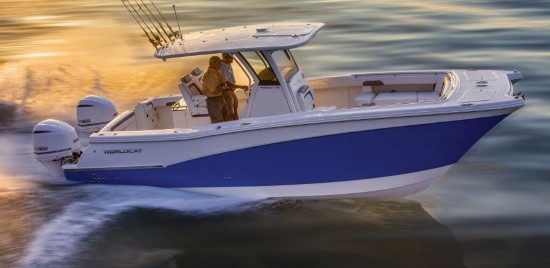
Distinguishing Features
- New Hull Design. VectorFlo tunnel is designed to reduce friction; new sheerline and tumblehome present a sleeker look; 3-piece hull allows more deck space.
- Glass Dash. New panel has Garmin GPSMAP 7612 12” (30.5 cm) chartplotter and digital switching.
- LED Docking Lights. Integrated into the hull. Gives the boat a high-tech look.
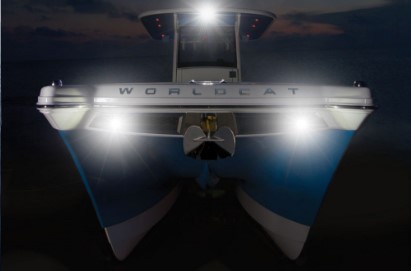
- Integrated Thru-Hull Anchor with Concealed Windlass. Comes with stainless-steel scuff plate, 300’ (91.4 m) of rode, 15’ (4.6 m) chain and a 22-pound (10-kg) anchor.
- Fiberglass Hardtop. New, "surfboard" style hardtop mounted on powder-coated frame with a built-in glass windshield. Includes a radio box, two rear and one forward-facing spreader lights and color-changing LED lights on the underside.
- Three-Bank Battery Charging System.
- Walkthrough Transom Door. Provides easy access to the wide swim ladder.
- Mechanical rooms in aft deck -- Provide easy access to key pumps, valves and switches.
Features Inspection
A New Approach. With over two years of development, the 280CC-X was designed to move catamaran design and performance forward to lure more monohull owners, while staying true to the classic catamaran benefits of ride and space. The top priority was aesthetics, as reflected in the sweeping sheerline, tumblehome aft, striking bow treatment, and maximum deck space permitted by the three-piece design. Two additional strategic elements of converting V-bottom users to catamarans were price and weight (due to the need for two hulls rather than one). Using its first all-CAD design, advanced materials and infusion, World Cat held down the weight of the 280CC-X and powered it with twin 200-hp Yamahas for a light, agile boat.
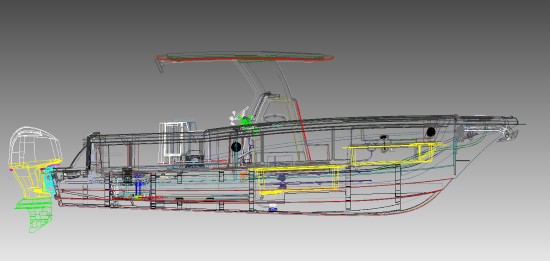
Hull Design
World Cat hulls and decks are designed using CAD/CAM 3D modeling. The 280CC-X’s twin hulls are designed with precisely shaped and sized planing surfaces based on World Cat’s other successful planing hulls; the running surfaces and the VectorFlo tunnel shape all contribute to achieving the classic smooth catamaran ride with maximum efficiency.
In our tests, we spooled the 200s up to their maximum 5900 rpm and reached 48.7 mph (42.3 knots). At 3500 rpm, we reached her most efficient cruise, which had us running at 25.6 mph (22.3 knots) where the 10.2 gph fuel burn turned in 2.5 mpg and a range of 444 miles. All while holding back a 10% reserve of fuel.
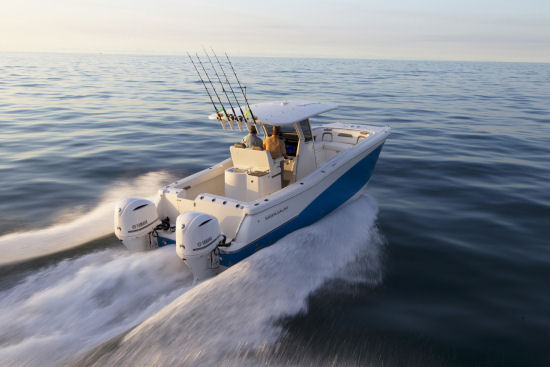
Construction. World Cat builds the 280CC-X from three primary pieces -- hull, deck liner and deck ring -- to provide the most available interior space. This added space is particularly noticeable in the aft cockpit area, making the fishing area especially spacious.
Behind the gelcoat, a 100% vinylester barrier coat is applied to protect against blistering. Next up is a hand-laid fiberglass chopped strand mat skin coat followed by alternating layers of hand-laid 17 oz. bi-axial and 36 oz. tri-axial knitted fiberglass cloth throughout the entire hull. The transom and forward anchor locker bulkhead are formed out of high-density composites; stringers and other bulkheads are fiberglass reinforced polyurethane preforms. After all internal accessories are installed in the hull, the deck liner is lowered in place and bonded to the tops of the stringers, and finally the deck ring is bonded and mechanically fastened to the hull and deck liner.

Handling
Before the whining starts from the monohull sales people, yes it’s a cat and yes it turns relatively flat instead of leaning into the turns like a typical V-bottom. If that’s your only gripe then cat operators have you at a disadvantage because there’s no V-hull that will penetrate heavy seas like a cat. We had moderate 1’ (.31 m) swells to play in on test day and it wasn’t a fair way to show just how well this boat could take some punishment. Frankly, we were hoping for a named storm but we also hope a Sports Illustrated swimsuit model joins us for dinner. Both end in disappointment.
However, Fort Lauderdale’s Port Everglades is rife with large yachts that produce more than their fair share of massive wakes so we spent plenty of time chasing down one after another and it was not only telling, it was downright fun.
We sliced cleanly through the heavy stuff with not a hint of pounding thanks to the heavy build process transferring any impact throughout the entire hull. Her twin hulls with their narrow entries did the rest. There was minimal spray as we transitioned through the waves and the faster we went the better the penetration. So in short, when the going gets rough, slowing down is not necessarily the correct way to deal with it. Ahh the life of a cat.
Now About Those Turns. If we slowly enter a turn she’ll stay flat, or lean just slightly into the turn. After the third turn it’s no longer a unique event and it becomes normal, so again… mono-hull guys, get over it. If we put her into a power turn, she’ll come over about 5 to 7-degrees but the force still moves the body to the outside of the turn. But since we don’t really spend our days on the water driving in circles, so what. Where the turns shine is in the tight radius. The circles were only slightly larger than the boat’s length and there was no hint of prop ventilation, even when entering the turn from a trimmed condition.
Redundancy
Cats also excel over monohulls in systems redundancy. The fuel, propulsion, and electrical systems are independent on either side so one engine shutting down does not translate into the other going down with it. We can always get home. Which begs the question… are we getting home at a measly trawler speed on one engine?
Well to find out, we shut one engine down, trimmed it out of the water and hit the throttle on the other engine fully expecting the result to be like we cut her legs out from under her.
Surprise! We jumped on plane and quickly trimmed her into a 20 mph cruise… on a single engine! Try that on a monohull and see what happens.
Features Inspection
Bow
The bow is where World Cat focused on making the area more comfortable and spacious, and in our opinion, it succeeded. With such a wide stance this is another of those areas where a monohull can’t touch a cat. There’s space for seven passengers on upholstery that features diamond patterned contrast stitching for durability and longevity. The padding is clearly thicker than we usually see and we also noticed varying densities of foam providing more support in strategic areas.
Elliptically shaped rails that are recessed below deck level encircle the bow. Outboard on each side in the gunwales are personal areas with 6-quart (5.7-L) open-top, self-draining coolers. The bow also has twin, under-seat 180-quart (170.3-L) insulated lockers that drain overboard as well as a 36-quart (34 L) cooler compartment forward. For convenience there are four stainless steel cup holders and two 12-volt power plugs. The only thing missing from the equation are USB plugs for both stereo connectivity to supplement the Bluetooth and to allow for charging devices while spending time onboard.
In the foredeck, a diamond non-skid decking has twin hatches. To port is an open storage area where we deposited our four fenders and dock lines. To starboard is the rode locker and here we also had an electric quick-drop windlass. Now this windlass location is significant. Firstly, it cleans up the bow area for a sleeker look and keeps the ground tackle neatly concealed. Secondly, the anchor is in the center of the two hulls, but the windlass is to starboard, which means that the rode makes a 90-degree turn as it makes its way out the stainless steel roller. A pair of foot switches (well, finger switches in this case) are mounted just above the windlass. There is a second set of controls at the helm.

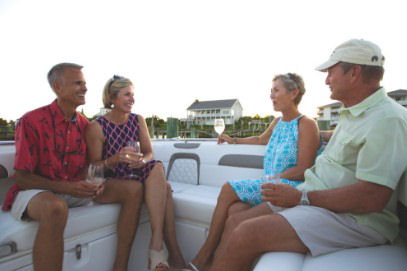
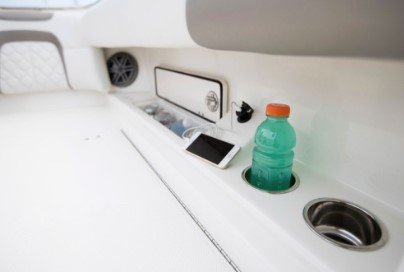
Head
Working aft, there is a molded-in seat on the front of the console and the entire seat assembly opens to provide easy access to the private head compartment. The fully fiberglass lined area provides a surprising amount of headroom and includes SeaDek/Flexiteek flooring, a freshwater head with a 9-gallon (34 L) holding tank, and overboard draining. There is also a Corian countertop, mirror, and storage for toiletries. A hatch provides access to the helm rigging and accessories.

The Console
A white powder-coated frame that’s cleanly integrated into the console provides strong support for the fiberglass hardtop with a “surfboard” edge. The glass windshield is also integrated into the structure for a finished look and negating the irritating pattern of adding Isinglass to the top. We would like to see a vent at the top of the windshield, however. The 280CC-X comes standard with a pantograph-style marine windshield wiper with rinse.

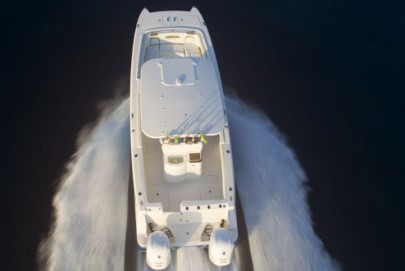
Helm
World Cat’s Glass Dash makes its debut on the 280CC-X and it comes standard with a Garmin GPSMAP 7612xsv 12” (30.5 cm) touchscreen chartplotter with an Airmar B117 depth/temperature thru-hull transducer and a Yamaha Command Link gauge. There’s ample room for a second display. All switching is done with a C-Zone digital platform accessed through the touch panel. Digital switching works behind the scenes, pulling all of the boat’s controls together for an integrated, highly customizable display setup. Depending on the captain’s preferences, the screen (or optional additional screen) can show any combination of navigation, engine monitoring or switching, making boat operation much simpler. An optional key fob even allows lighting the boat and activating the battery as you’re walking down the dock.
The stainless-steering wheel with a spinner knob and engine controls are positioned for the driver to run the boat from the port side. The helm is topped in a stitched matte vinyl while the panel is a gloss black Lexan. A Fusion stereo with Bluetooth puts out the tunes through 4 JL Audio speakers. A locking glovebox provides secure weather-resistant storage and contains a 12-volt plug.

Functional Comfort
The captain and a companion should have a comfortable ride to the fishing grounds thanks to the 280CC-X’s adjustable helm seats that have flip-up bolsters and flip-down armrests. On the aft side of the leaning post, there’s a 30-gallon (114 L) insulated livewell with a clear hatch, 1,100-gph (4,164-lph) magnetic drive pump and an overboard drain. It has a Corian countertop plus tool and tackle storage. In the base is a management center for three batteries with parallel capability. 
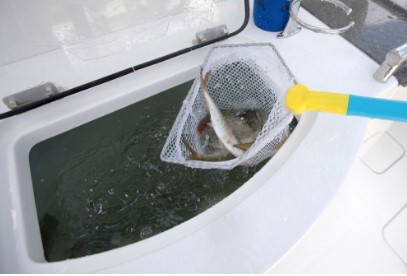

Time to Fish
Abaft the leaning post, the 280CC-X’s cockpit offers open fishing space with full coaming pads lining the gunwales. A fold-down bench seat has space for two people during the run to the fishing grounds. To keep millennials happy, there are two 12-volt plugs adjacent to the seat, which again, could use USB connectivity. There are four stainless-steel rod holders in the gunwales plus another four across the transom and a centrally-mounted door makes it easy to haul in a big fish. Twin insulated 355-quart (336 L) lockable fishboxes outboard on each side have diaphragm pumps and can alternately be used to store four fishing rods or a 5-gallon (19 L) bucket. There are fresh and raw-water washdowns. To facilitate maintenance, there are twin in-deck mechanical rooms with large hatches that provide access to twin aft 1,500-gph (5,678.1-lph) bilge pumps, water tanks, and wash down pumps.
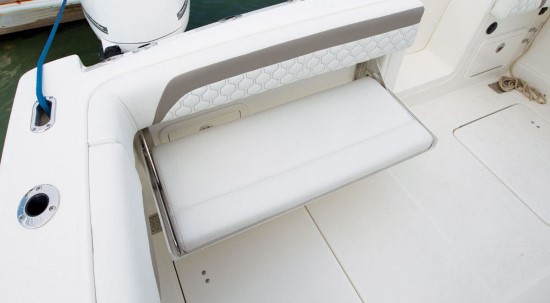
Includes twin Yamaha F200 four-stroke outboards with Command Link gauge, as well as the deluxe electronics package including Garmin GPSMAP 7612xsv 12” monitor, Airmar transducer, and CZone digital switching.
Warranty
10 year limited Hull Warranty.
Options to Consider
- Custom white paint for Yamaha outboards
- Five-rod rocket launcher mounted on hardtop
- SeaDek accent package on the console interior, helm deck, and motor well
- Taco Marine Grand Slam 380 top-mount outriggers with 18’ (5.5 m) telescopic poles
- Polished 22-pound (9.9 kg) stainless-steel anchor
- Edson satin-finish steering wheel with power knob
- High-grade 3-sided curtain package with Strataglass
- Second Garmin GPSMap 7612xsv 12” (30.5 cm) -touch display with Airmar B117 depth/temperature thru-hull transducer
- Single Garmin GPSMap 7616xsv 16” (40.6 cm) multi-touch display with Airmar B117 depth/temperature thru-hull transducer (replaces standard 12” (30.5 cm) model)
- Two Sea Vision surface-mount blue LED underwater lights
- CZone key fob remote control
- Optimus electronic steering system
- Optimus 360 system with electronic steering, SeaStation and joystick
- Full-hull or two-tone hull color pattern in Flag Blue, Tanglewood Tan, Platinum Gray, Ice Blue, Sea Foam Green, or Empress Blue
- Matching hardtop underside to hullside color
Observations
With the 280CC-X, World Cat went with a less is more approach. Marrying a lighter hull with twin Yamaha 200s makes the boat more affordable and reduces the overall weight, which allows the catamaran design to make the most of its efficiency when compared to a similarly sized and powered V-bottom. And there is no reduction in the classic catamaran performance.
She’s also designed as a multi-purpose model with a focus on improved cruising comfort and amenities in the bow and head compartment, creating an attractive overall package. We’ve yet to see a monohull that can compare with the spacious layout of a cat. A pontoon can do it but that’s about it. So from the family’s eye, this is flat out comfort.
To the test captain’s eye, the real attraction is in redundancy. With the two hulls, there are also two electrical systems, two battery systems, two fuel systems, and two propulsion systems. All independent of each other. So unless we fuel both tanks with bad gas (or worse… diesel) then one engine shutting down is not going to be a problem that carries over to the other. And as we’ve shown, we can cruise along just fine on a single engine. Such is the cat life.

